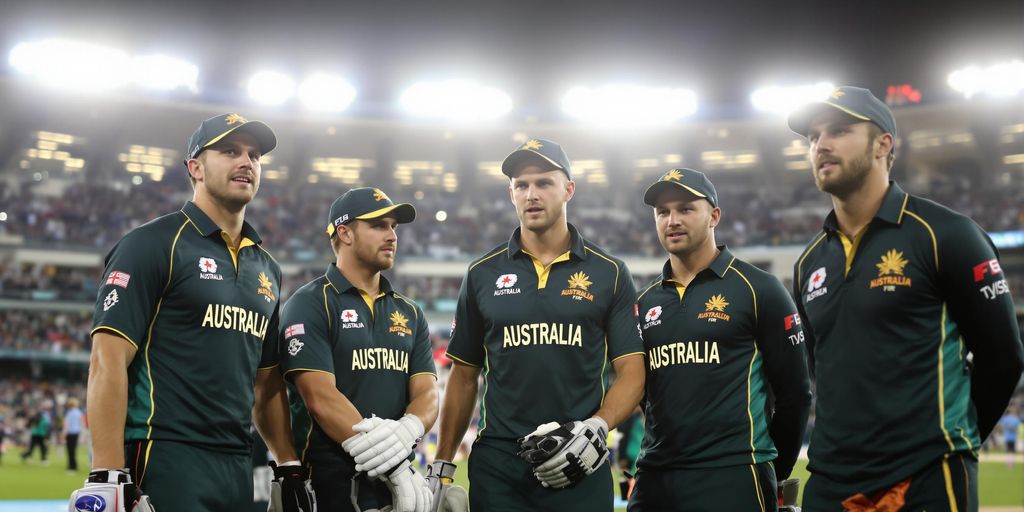Current Trends In Australian Cricket Players Salary Per Month
Overview Of Salary Increases
Righto, let’s have a squiz at how the pay packets for our Aussie cricketers are looking these days. There’s been a fair bit of movement, especially with the blokes getting a 7.5% bump in their retainers last year. That new Memorandum of Understanding (MOU) has really shaken things up.
- Average retainer for the men is sitting pretty at around $951,000.
- Top earners are raking in over $3 million a year, bonza!
- Even the minimum retainer is a respectable $367,000 before you even chuck in tour payments and match fees.
Impact Of Recent Contracts
These new contracts are a game-changer, no doubt. We’ve seen some fresh faces getting contracts for the first time, like Xavier Bartlett, Nathan Ellis, Matt Short, and Aaron Hardie. Consistent performances are finally getting rewarded, which is great to see. On the flip side, some of the older guard and younger players who haven’t quite hit their straps have missed out. It’s a tough gig, but that’s cricket, eh?
Comparison With Previous Years
Compared to previous years, the pay is definitely on the upswing. The increase in the BBL salary cap, from $2 million to $3 million, is a massive jump.
This means blokes can earn up to $420,000 in the BBL alone. The women’s game is also seeing some serious investment, with the WBBL salary cap going up to $732,000. It’s a good time to be a cricketer in Australia, that’s for sure.
Here’s a quick look at how things have changed:
| Category | Previous Salary Cap | Current Salary Cap | Increase |
|---|---|---|---|
| Men’s BBL | $2 million | $3 million | 50% |
| Women’s WBBL | (Not Specified) | $732,000 | New Cap |
Key Factors Influencing Player Salaries
Performance Metrics
Player performance is a massive factor, obviously. If you’re consistently scoring runs, taking wickets, or saving runs in the field, you’re going to be in a stronger position to negotiate a better contract. It’s not just about raw stats, though. Things like strike rate, economy rate, and even fielding efficiency are looked at closely. Selectors and team management use these metrics to gauge a player’s overall value to the team.
Market Demand
Market demand plays a big role. If there are multiple teams vying for a player’s signature, their price is going to go up. This is especially true for players with unique skill sets or those who fill a specific need within a team. Think of it like any other job market – high demand, limited supply, higher salaries.
Sponsorship Deals
Sponsorships can significantly boost a player’s overall earnings.
- Endorsements from brands.
- Appearance fees.
- Social media deals.
Players with a strong public image and a large following are more attractive to sponsors, which can translate into a substantial income stream on top of their base salary.
Player salaries aren’t just about what happens on the field. It’s a complex interplay of performance, market forces, and commercial appeal. All these things combined determine how much a player can earn.
Salary Breakdown By Player Categories
Top Contracted Players
Right, let’s talk dosh. The top-tier blokes, the ones with Cricket Australia contracts, are doing alright for themselves. These are your Smith’s, Warner’s, and Cummins’ – the big names. They’re pulling in an average of around $951,000 a year before match payments. And with the squad size increasing to 24, more players get a slice of that pie. It’s a good time to be a top-contracted Aussie cricketer, that’s for sure.
Emerging Talents
What about the up-and-comers? The young guns trying to make a name for themselves? Well, it’s a bit more varied. They might not be on those massive CA contracts just yet, but they’re getting there. A lot depends on state contracts and Big Bash League (BBL) deals. If they’re playing well, getting noticed, and snagging those gigs, they can earn a decent living. It’s all about proving their worth and climbing the ranks. Consistency is key for these players.
Women Cricketers Salaries
Now, this is where things get interesting. There’s been a big push for equal pay in cricket, and the women’s game is seeing some serious growth. The big winners are female cricketers, whose pay will increase by almost 66 per cent across the board to a combined $133 million over the life of the agreement. The WBBL salary cap is set to increase to $732,000 per year. CA will increase the women’s national contract list from 15 to 18, with a 25 per cent pay increase for them. Domestic players will benefit with an average pay packet of $151,000, with the majority earning in excess of $100,000. Players will need to hold a state and WBBL contract to achieve that mark, with around 75 per cent of the cohort doing so.
It’s great to see the investment in women’s cricket. It’s not just about fairness; it’s about recognising the value and potential of the women’s game. More money means better players, better competition, and a brighter future for the sport as a whole.
Comparison Of Domestic And International Salaries
State Contracts
State contracts are a pretty big deal for Aussie cricketers. They’re the foundation, really. These contracts provide a base salary, allowing players to focus on improving their game without stressing too much about where the next pay cheque is coming from. The average domestic player can expect to earn around $151,000, provided they hold both a state and WBBL contract. It’s worth noting that about 75% of players manage to snag both, which is a decent chunk.
Big Bash League Earnings
The Big Bash League (BBL) is where things get a bit more interesting. It’s the glamour tournament, and the salaries reflect that. With the men’s BBL salary cap now at $3 million, top earners can pocket up to $420,000 just for a few weeks of cricket. That’s a serious payday! The WBBL is also seeing a boost, with the salary cap increasing to $732,000 per year. This is all part of an effort to keep our leagues competitive with the likes of the Women’s Hundred in England and India’s WPL.
International Match Fees
Playing for Australia is the pinnacle, and the pay reflects that too. Centrally-contracted male players now average $951,000 before match payments, which is a 7.5% increase. Add in match fees, and you’re looking at a very comfortable income. Of course, these contracts are highly sought after, and only the best make the cut. The women’s national contract list is also expanding, going from 15 to 18 players, with a 25% pay increase to boot.
It’s interesting to see how the pay is structured. Domestic cricket provides a stable base, the BBL offers a lucrative short-term boost, and international cricket is where the big bucks and prestige are. Each level plays a vital role in the overall financial landscape for Australian cricketers.
Impact Of The Indian Premier League On Salaries

The Indian Premier League (IPL) has completely changed the landscape of cricket salaries, especially for Aussie players. It’s not just about the money they earn during the tournament; it’s the knock-on effect it has on their overall earning potential. Let’s have a look at how the IPL influences the paychecks of our cricketers.
IPL Earnings For Australian Players
The IPL is a goldmine. Aussies are highly sought after, and the salaries they command in the IPL often dwarf what they earn from Cricket Australia. Take, for example, the recent auction where several Australian players secured lucrative deals. These earnings can significantly boost their annual income, making them some of the highest-paid cricketers globally. In March 2025, there were 15 Australians participating in the IPL.
Contract Negotiations Post-IPL
The IPL performance directly impacts future contract negotiations. A stellar season in the IPL can increase a player’s market value, giving them more leverage when negotiating contracts with Cricket Australia or other domestic leagues like the Big Bash. It’s a simple case of supply and demand; a player in high demand after a successful IPL stint can command a higher price. This is especially true for players looking for cricket news.
Player Retention Strategies
Teams are now developing strategies to retain their key players, especially those who perform well in the IPL. This might involve offering longer contracts or higher match fees to ensure they don’t lose them to other leagues. The competition for talent is fierce, and teams are willing to pay a premium to keep their star players happy and on their roster.
The IPL has forced Cricket Australia to rethink its player retention strategies. They need to ensure that Australian players are incentivised to stay and play in domestic competitions, rather than being lured away by the higher salaries and shorter seasons of the IPL.
Here’s a quick look at how IPL earnings can stack up:
| Player | IPL Salary (Approx. AUD) |
|---|---|
| Pat Cummins | $3.5 million |
| Mitchell Starc | $3.0 million |
| Other Aussies | $1 – $2 million |
It’s a big game changer, no doubt.
Future Projections For Player Salaries
Expected Salary Growth
Looking ahead, Aussie cricketers are set to see some decent pay rises. The recent MOU between CA and the ACA has already paved the way for significant increases, especially for the women’s game. We can expect this trend to continue, with salaries growing steadily across all formats. The BBL’s salary cap increase to $3 million is a clear sign that Cricket Australia is serious about attracting and retaining top talent. It’s not just the top blokes either; domestic players are also looking at a more comfortable future with average pay packets on the up.
Influence Of Global Tournaments
Global tournaments like the IPL and the upcoming T20 World Cups will continue to play a massive role in player earnings. The IPL, in particular, has become a game-changer, offering lucrative contracts that can significantly boost a player’s overall income.
Players are now strategically planning their careers around these tournaments, and their performance in these events directly impacts their market value. The more they shine on the global stage, the bigger the bucks they can command.
Here’s a quick look at how global tournaments can affect earnings:
- Increased visibility to international franchises.
- Higher endorsement opportunities.
- Potential for record-breaking auction bids (like Pant’s).
Long-Term Contracts
Long-term contracts are becoming more common, offering players financial security and stability. These deals often include performance-based incentives and bonuses, rewarding consistent excellence. For example, Cricket Australia increased the women’s national contract list from 15 to 18, with a 25 per cent pay bump. These contracts are not just about the money; they also provide players with the peace of mind to focus on their game.
Consider these factors when looking at long-term contracts:
- Contract length and terms.
- Negotiation strategies.
- Impact on team dynamics.
Salary Disparities Among Different Formats
It’s a fair dinkum reality that what a cricketer earns can swing wildly depending on whether they’re slogging it out in a Test match, smashing sixes in a T20, or grinding through an ODI. Let’s have a squiz at how these differences play out.
Test Cricket Salaries
Test cricket, often considered the pinnacle, doesn’t always translate to the biggest paychecks these days. While Test players enjoy solid base salaries and match fees, the sheer time commitment can mean they miss out on more lucrative short-format opportunities. Test cricket is still highly valued, but it doesn’t always mean the biggest bucks.
ODI And T20 Salaries
ODI and T20 formats are where the real money often is. The shorter duration means players can participate in more leagues and tournaments, boosting their earnings through match fees, bonuses, and endorsements. T20 leagues, in particular, have become a goldmine for many cricketers. The WBBL salary cap is increasing to keep pace with other leagues.
Impact Of Format On Earnings
Format undeniably impacts earnings. A player who excels in T20s might earn significantly more than a Test specialist, even if the latter is considered a more accomplished all-round cricketer. This disparity can influence career choices, with some players focusing on developing skills suited to the shorter formats to maximise their earning potential.
The rise of T20 leagues has created a two-tiered system. Players who are in demand for these leagues can command huge salaries, while those focused on Test cricket might find themselves comparatively underpaid. This is a growing concern for cricket boards, who are trying to balance the appeal of Test cricket with the financial realities of the modern game.
Here’s a quick look at how match fees might compare (these are illustrative figures, of course):
| Format | Approximate Match Fee (AUD) |
|---|---|
| Test Cricket | $20,000 – $30,000 |
| ODI | $10,000 – $15,000 |
| T20 | $5,000 – $10,000 |
Keep in mind that these are just match fees. Bonuses, endorsements, and league contracts can significantly alter the overall earnings picture.
Role Of Sponsorship In Player Earnings
Endorsements And Brand Deals
Alright, let’s have a yarn about how sponsorships chuck a shrimp on the barbie for our cricketers’ wallets. It’s not just about hitting sixes and taking wickets; it’s also about how well they can flog everything from sports gear to brekkie cereal. Endorsements are a massive part of the game these days, and some players are basically walking billboards. Think about it: a good-looking bloke or sheila smashing it on the field, then popping up in an ad – it’s gold for brands. The bigger the profile, the fatter the cheque.
Impact Of Social Media
Social media, eh? It’s gone bonkers, hasn’t it? For cricketers, it’s not just about posting holiday snaps; it’s a whole new ball game for earning dosh. Instagram, Facebook, and all those platforms give players a direct line to fans and, more importantly, to brands looking for influencers. A well-placed post can earn a player a tidy sum, and it’s all about building that personal brand. The more followers, the more influence, and the more brands are willing to pay for a shout-out. It’s a bit of a popularity contest, but hey, it pays the bills.
Player Marketability
Right, so what makes a player marketable? It’s not just about being good at cricket, though that helps a fair bit. It’s about having that ‘it’ factor – the charisma, the relatability, the story that people connect with. Think of blokes like Alyssa Healy’s performance – she’s not just a gun cricketer; she’s got a great personality, she’s articulate, and she’s got a strong presence. Brands want to be associated with that. It’s also about being clean-cut (mostly), staying out of trouble, and generally being a good role model.
At the end of the day, sponsorship is a business. Brands are looking for a return on their investment, and they’ll back players who they think can deliver that. It’s a tough game, but for those who crack it, the rewards can be huge. It’s all part of the modern cricket landscape, and it’s only going to get bigger.
Historical Context Of Australian Cricket Salaries
Evolution Over The Decades
Crikey, mate, let’s have a yarn about how much cricketers get paid these days compared to back in the day. It’s a different world, I tell ya! In the olden days, cricketers were practically amateurs. They played for the love of the game, and maybe got a bit of pocket money. Now, it’s a proper profession, with blokes earning more than some CEOs. The shift from amateurism to professionalism has been a slow burn, but a significant one.
Major Milestones
There have been a few big moments that changed the game, salary-wise.
- The introduction of limited-overs cricket and the subsequent rise of the Big Bash League (BBL) really shook things up. Suddenly, there was more money floating around, and players could earn a decent quid playing in these shorter formats.
- The Packer Revolution in the 70s was another game-changer. Kerry Packer threw a heap of money at cricket, and players started getting paid proper wages for the first time. It caused a bit of a ruckus at the time, but it paved the way for the modern game.
- The rise of the Indian Premier League (IPL) has had a massive impact. Aussie players can now earn fortunes playing in India, which has driven up salaries across the board. It’s a global market now, and players are in demand.
Back in the day, a good season might get you a pat on the back and a mention in the local paper. Now, it can get you a multi-million dollar contract. It’s a sign of how much the game has grown, and how much value we place on our cricketers.
Influential Players
Some players have been instrumental in pushing for better pay and conditions. Blokes like Dennis Lillee and Greg Chappell were always fighting for a fair go, and they helped to raise the profile of the game and the players. More recently, players like Steve Smith and Pat Cummins have used their influence to negotiate better deals for all cricketers, not just the top dogs. These blokes understood the importance of memorandum of understanding and fair compensation.
Salary Cap Regulations In Australian Cricket

Current Salary Cap For WBBL
Right, so the WBBL’s got a salary cap, yeah? It’s there to try and keep things fair, so one team can’t just buy up all the best players. The cap’s been going up lately, trying to keep pace with other women’s leagues around the world. As of now, the WBBL salary cap sits at $732,000 per year. This increase is a big deal, aiming to keep our domestic competition competitive against leagues like the Women’s Premier League (WPL) in India and The Hundred in England. It’s all about attracting and keeping top talent here in Australia.
BBL Salary Structures
Now, let’s talk about the blokes. The BBL’s salary cap is a bit different. It’s higher, reflecting the bigger revenue and higher player costs. The BBL salary cap has been increased to $3 million. This allows teams to pay their top players a decent whack, hopefully keeping them from running off to other leagues. Players can earn up to $420,000. This is all part of keeping the BBL a top-tier competition and a key part of the Aussie summer. The increase in the men’s BBL salary cap is a big step in ensuring the league remains competitive on a global scale.
Future Changes In Regulations
Looking ahead, who knows what’ll happen? The salary caps in both the WBBL and BBL are likely to keep changing. It all depends on how much money the leagues are making, what the players want, and what other leagues are doing. There’s always talk about tweaking the rules to make things fairer or to encourage certain types of players.
It’s a constantly evolving landscape, with Cricket Australia and the Australian Cricketers’ Association always in talks to make sure the regulations are fair and sustainable for the future of Australian cricket.
Here are some things that might influence future changes:
- Revenue from broadcasting rights
- Sponsorship deals
- The overall health of Australian cricket
Player Contracts And Their Implications
Contract Lengths And Terms
Player contracts in Aussie cricket are more than just a piece of paper; they’re the foundation of a player’s career and financial security. Contract lengths can vary, usually spanning from one to three years, but longer deals aren’t unheard of for established stars. The terms outline the base salary, potential bonuses based on performance, and clauses related to image rights and sponsorship obligations. These contracts also specify the player’s availability for different formats of the game and any restrictions on playing in overseas leagues. It’s a complex negotiation, balancing the player’s worth with the team’s budget and future plans.
Negotiation Strategies
Negotiating a cricket contract is a high-stakes game. Players often employ agents to represent them, leveraging performance stats, market demand, and even potential interest from rival teams. Cricket Australia (CA) and state associations have their own strategies, focusing on team balance, salary caps, and long-term player development. Data analytics now play a big role, with teams using metrics to assess a player’s true value. A key aspect is understanding the current landscape of player salaries and benchmarking against similar players. It’s a delicate dance of power, information, and strategic positioning.
Impact On Team Dynamics
Player contracts have a huge ripple effect on team dynamics. A well-structured contract can boost morale and create a stable environment, while a poorly handled negotiation can lead to resentment and disharmony. When a star player is on a lucrative deal, it can put pressure on them to perform, but it can also inspire teammates to raise their game. Salary disparities can sometimes cause friction, so teams need to manage expectations and ensure a fair and transparent system. The leadership group plays a vital role in maintaining team cohesion, regardless of individual contract values.
Contracts are a constant topic of conversation in the sheds. Everyone knows what everyone else is earning, more or less. It’s up to the senior players and coaches to make sure that doesn’t become a distraction and that the focus remains on winning games.
Here are some key considerations for teams:
- Maintaining a balanced squad within the salary cap.
- Ensuring fair compensation for all players.
- Promoting a culture of teamwork and mutual respect.
- Addressing any potential conflicts arising from contract differences.
Economic Factors Affecting Cricket Salaries
Inflation And Cost Of Living
Look, let’s be real, the price of everything’s going up, right? That includes a decent meat pie at the cricket. So, naturally, inflation plays a big role in what cricketers need to earn just to maintain their lifestyle. As the cost of living increases, so too does the pressure on Cricket Australia to offer contracts that keep pace. It’s not just about the fancy cars; it’s about being able to afford a home and support a family, especially with the short career span of a professional athlete.
Revenue From Broadcasting Rights
Broadcasting rights are where the big bucks are. Think about it: every time a channel pays to show a game, that money flows back into the sport.
- More viewers = more ad revenue.
- More ad revenue = bigger broadcasting deals.
- Bigger broadcasting deals = more money for players.
It’s a pretty simple equation. The more popular cricket is on TV and streaming services, the more money there is to go around. This directly impacts player salaries, making it a very rich cricketers game for those at the top.
Sponsorship Trends
Sponsorships are another huge piece of the pie. Companies are willing to pay big money to have their brand associated with popular players and teams. These deals can range from endorsements to having a logo plastered on a player’s bat or shirt.
The rise of social media has also changed the game. Players with large followings can command even higher sponsorship fees because they offer brands direct access to a massive audience. It’s all about marketability these days, and players who can build a strong personal brand are in a much better position to negotiate lucrative deals.
Here’s a quick look at how sponsorship trends can affect earnings:
| Trend | Impact on Player Earnings |
|---|---|
| Increased Social Media | Higher endorsement deals for players with large followings |
| Niche Brand Deals | Opportunities for players to align with specific brands |
| Global Sponsorships | Increased earning potential for internationally known players |
Wrapping It Up
So, there you have it. The salaries of Australian cricket players in 2025 are pretty impressive, reflecting the growth of the sport and the increasing competition. With the average retainer sitting at around $951,000, and top players raking in over $3 million, it’s clear that cricket is a lucrative career choice. Female players are also seeing a significant pay rise, which is great for the game. As the sport continues to evolve, it’ll be interesting to see how these figures change in the coming years. For now, it’s safe to say that being a cricketer in Australia is not just about the love of the game, but also about making a solid living.




